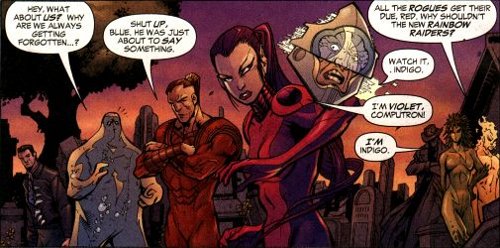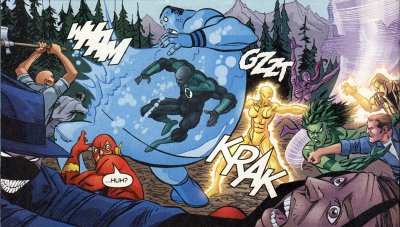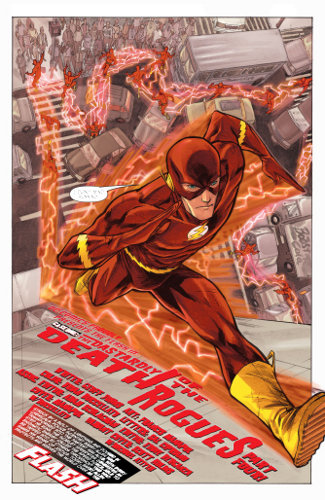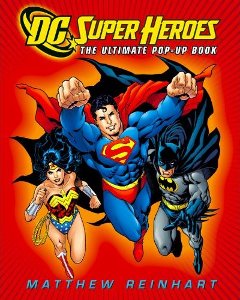It used to be a joke, “As long as you keep buying late books, we’ll keep making ’em.” It’s not a joke anymore: you stopped buying ’em. We need to get our schedule under control.
— Dan Didio at DC Nation, C2E2 (as reported by CBR).

It used to be a joke, “As long as you keep buying late books, we’ll keep making ’em.” It’s not a joke anymore: you stopped buying ’em. We need to get our schedule under control.
— Dan Didio at DC Nation, C2E2 (as reported by CBR).
Amazon is running a serious discount on Paul Levitz’ massive tome of comic-book history, 75 Years of DC Comics: The Art of Modern Mythmaking. The 720-page coffee table book weighs in at 16 pounds and normally sells for $200. Amazon initially listed it for $126, but it’s down to $109.66 — a 45% discount cutting $90 off the price!
I finally ordered a copy.
I doubt this discount will last. If a huge, detailed art book about DC Comics’ history appeals to you but (like me) you’ve been holding out because of the price, now’s your chance!
Sometimes, a new character or team just clicks.
Sometimes…they don’t.
This was the case with the Rainbow Raiders.

During his 2000-2005 run on The Flash, Geoff Johns killed off the Rainbow Raider, a Bronze-Age Rogue who could shoot colored energy beams and could drain or add color to people and objects, changing them based on the characteristics of that color. Red would enrage someone, yellow would make them afraid, etc. He was killed by Blacksmith in the prologue to “Crossfire” (Flash #183, 2002), presumably with the thought that he had less potential alive than as an example of how tough the new villain was.
Ironically, a few years later, Geoff Johns would introduce the concept of the emotional spectrum to the Green Lantern mythos, on which he built Blackest Night and Brightest Day. The Rainbow Raider’s powers would have fit right in.
Comics publishers never like to leave a name unused, and a few years later, Johns introduced the Rainbow Raiders in the pages of The Flash. They didn’t do much other than introduce themselves at Captain Boomerang’s funeral (Flash #217, 2005).
As far as I know, the villains have only been used once since then, just one month after their initial appearance: in JLA: Syndicate Rules (Kurt Busiek), Johnny Quick and Power Ring of the Crime Syndicate are impersonating the Flash and Green Lantern while they stumble upon an attack in progress by the Raiders. They have to fight or else blow their cover, but they don’t have the heroes’ restraint with using their powers, and make brutally short work of the Raiders.

That was pretty much it, and even I forgot about them until last week, when they showed up on a list of characters killed during Blackest Night.
“Wait? What?”
Lia was kind enough to point me to relevant posts on The Rogues Kick Ass from a couple of months ago (page 1and page 2). It turns out a two-page sequence in Untold Tales of Blackest Night revealed their ultimate fate: On discovering that the dead are rising, they decide to be on the winning side…so they kill themselves. They don’t even rise as Black Lanterns, though, because no heroes actually care about them enough for the rings to re-animate them.
2010 was a big year for the Flash. After five years of meandering (since DC decided to cancel Wally West’s series during Infinite Crisis because, hey, you can’t have a Crisis without a dead Flash, but couldn’t figure out what to do with the relaunch), it’s beginning to look like DC has finally gotten the character back on track.

The year opened with the wrap-ups of the Flash: Rebirth and Blackest Night: The Flash miniseries, then ran headlong into the Flash vol.3 relaunch in April by Geoff Johns and Francis Manapul. The new series starring Barry Allen has completed its first story arc, introduced new characters in the form of reverse-Rogues, and presented two Rogue Profile spotlight issues. On the downside, the series has been plagued by delays since summer, and those two Rogue spotlights were added to help get the book back on schedule.
Barry Allen has been all over the place: The Flash, Blackest Night, Brightest Day, Green Lantern… A number of Barry Allen/Flash action figures have also been released or announced this year.
Bart Allen, as Kid Flash, has rejoined the Teen Titans.
Jay Garrick continues to be a mainstay of the Justice Society of America.
On TV, Batman: The Brave and the Bold featured a Flash-focused episode starring Jay Garrick, Barry Allen and Wally West (as Kid Flash)…with John Wesley Shipp voicing Professor Zoom. Cartoon Network’s Young Justice launched with Kid Flash as a main character. And of course there’s the continuing presence of Flash fandom on The Big Bang Theory.
 This week sees the release of Matthew Reinhart’s DC Super-Heroes: The Ultimate Popup Book. The Source has some photos of the Superman, Wonder Woman and Batman pages, plus a video clip (though I couldn’t get it to play on my computer).
This week sees the release of Matthew Reinhart’s DC Super-Heroes: The Ultimate Popup Book. The Source has some photos of the Superman, Wonder Woman and Batman pages, plus a video clip (though I couldn’t get it to play on my computer).
If all goes well, a few minutes after this post goes live, I’ll be live-blogging the panel! Once it gets started, the view here should update automatically as I add to it.
11:30 Welcome to the Speed Force live coverage of the DC Nation Kickoff at SDCC! This is a bit of an experiment, and the network connection is pretty slow, so we’ll see how it goes.
11:31 Dan Didio is introducing himself and the panel
11:31 DD: There is no big announcement from DC, I think DC is big enough as it is!
11:32 DD: bringing someone back from the dead… Hawkgirl!
11:32 Bob Wayne is up next
11:33 Jeff Lemire
11:33 Bill Willingham now…
11:34 J.T. Krull & Nicola Scott
11:34 “The man who made Justice Cry….James Robinson”
11:36 DD: Last year everyone was saying there was too much Death in DC comics, and now they’re applauding it. (re: Action Comics) Continue reading